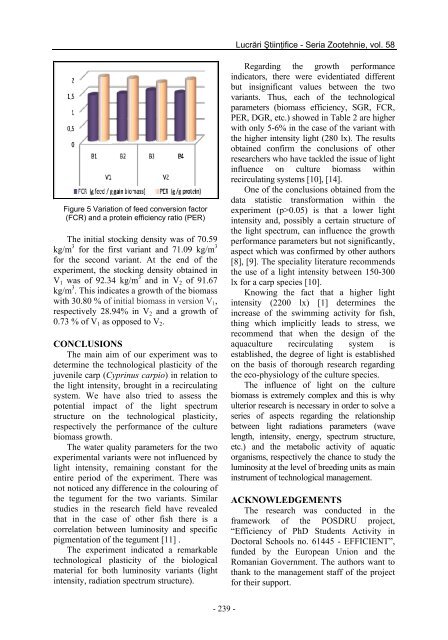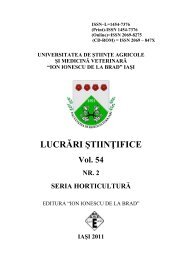the influence of light intensity on the growth performance of common ...
the influence of light intensity on the growth performance of common ...
the influence of light intensity on the growth performance of common ...
You also want an ePaper? Increase the reach of your titles
YUMPU automatically turns print PDFs into web optimized ePapers that Google loves.
Figure 5 Variati<strong>on</strong> <str<strong>on</strong>g>of</str<strong>on</strong>g> feed c<strong>on</strong>versi<strong>on</strong> factor<br />
(FCR) and a protein efficiency ratio (PER)<br />
The initial stocking density was <str<strong>on</strong>g>of</str<strong>on</strong>g> 70.59<br />
kg/m 3 for <str<strong>on</strong>g>the</str<strong>on</strong>g> first variant and 71.09 kg/m 3<br />
for <str<strong>on</strong>g>the</str<strong>on</strong>g> sec<strong>on</strong>d variant. At <str<strong>on</strong>g>the</str<strong>on</strong>g> end <str<strong>on</strong>g>of</str<strong>on</strong>g> <str<strong>on</strong>g>the</str<strong>on</strong>g><br />
experiment, <str<strong>on</strong>g>the</str<strong>on</strong>g> stocking density obtained in<br />
V 1 was <str<strong>on</strong>g>of</str<strong>on</strong>g> 92.34 kg/m 3 and in V 2 <str<strong>on</strong>g>of</str<strong>on</strong>g> 91.67<br />
kg/m 3 . This indicates a <strong>growth</strong> <str<strong>on</strong>g>of</str<strong>on</strong>g> <str<strong>on</strong>g>the</str<strong>on</strong>g> biomass<br />
with 30.80 % <str<strong>on</strong>g>of</str<strong>on</strong>g> initial biomass in versi<strong>on</strong> V1,<br />
respectively 28.94% in V2 and a <strong>growth</strong> <str<strong>on</strong>g>of</str<strong>on</strong>g><br />
0.73 % <str<strong>on</strong>g>of</str<strong>on</strong>g> V1 as opposed to V 2.<br />
CONCLUSIONS<br />
The main aim <str<strong>on</strong>g>of</str<strong>on</strong>g> our experiment was to<br />
determine <str<strong>on</strong>g>the</str<strong>on</strong>g> technological plasticity <str<strong>on</strong>g>of</str<strong>on</strong>g> <str<strong>on</strong>g>the</str<strong>on</strong>g><br />
juvenile carp (Cyprinus carpio) in relati<strong>on</strong> to<br />
<str<strong>on</strong>g>the</str<strong>on</strong>g> <str<strong>on</strong>g>light</str<strong>on</strong>g> <str<strong>on</strong>g>intensity</str<strong>on</strong>g>, brought in a recirculating<br />
system. We have also tried to assess <str<strong>on</strong>g>the</str<strong>on</strong>g><br />
potential impact <str<strong>on</strong>g>of</str<strong>on</strong>g> <str<strong>on</strong>g>the</str<strong>on</strong>g> <str<strong>on</strong>g>light</str<strong>on</strong>g> spectrum<br />
structure <strong>on</strong> <str<strong>on</strong>g>the</str<strong>on</strong>g> technological plasticity,<br />
respectively <str<strong>on</strong>g>the</str<strong>on</strong>g> <strong>performance</strong> <str<strong>on</strong>g>of</str<strong>on</strong>g> <str<strong>on</strong>g>the</str<strong>on</strong>g> culture<br />
biomass <strong>growth</strong>.<br />
The water quality parameters for <str<strong>on</strong>g>the</str<strong>on</strong>g> two<br />
experimental variants were not <str<strong>on</strong>g>influence</str<strong>on</strong>g>d by<br />
<str<strong>on</strong>g>light</str<strong>on</strong>g> <str<strong>on</strong>g>intensity</str<strong>on</strong>g>, remaining c<strong>on</strong>stant for <str<strong>on</strong>g>the</str<strong>on</strong>g><br />
entire period <str<strong>on</strong>g>of</str<strong>on</strong>g> <str<strong>on</strong>g>the</str<strong>on</strong>g> experiment. There was<br />
not noticed any difference in <str<strong>on</strong>g>the</str<strong>on</strong>g> colouring <str<strong>on</strong>g>of</str<strong>on</strong>g><br />
<str<strong>on</strong>g>the</str<strong>on</strong>g> tegument for <str<strong>on</strong>g>the</str<strong>on</strong>g> two variants. Similar<br />
studies in <str<strong>on</strong>g>the</str<strong>on</strong>g> research field have revealed<br />
that in <str<strong>on</strong>g>the</str<strong>on</strong>g> case <str<strong>on</strong>g>of</str<strong>on</strong>g> o<str<strong>on</strong>g>the</str<strong>on</strong>g>r fish <str<strong>on</strong>g>the</str<strong>on</strong>g>re is a<br />
correlati<strong>on</strong> between luminosity and specific<br />
pigmentati<strong>on</strong> <str<strong>on</strong>g>of</str<strong>on</strong>g> <str<strong>on</strong>g>the</str<strong>on</strong>g> tegument [11] .<br />
The experiment indicated a remarkable<br />
technological plasticity <str<strong>on</strong>g>of</str<strong>on</strong>g> <str<strong>on</strong>g>the</str<strong>on</strong>g> biological<br />
material for both luminosity variants (<str<strong>on</strong>g>light</str<strong>on</strong>g><br />
<str<strong>on</strong>g>intensity</str<strong>on</strong>g>, radiati<strong>on</strong> spectrum structure).<br />
- 239 -<br />
Lucrări Ştiinţifice - Seria Zootehnie, vol. 58<br />
Regarding <str<strong>on</strong>g>the</str<strong>on</strong>g> <strong>growth</strong> <strong>performance</strong><br />
indicators, <str<strong>on</strong>g>the</str<strong>on</strong>g>re were evidentiated different<br />
but insignificant values between <str<strong>on</strong>g>the</str<strong>on</strong>g> two<br />
variants. Thus, each <str<strong>on</strong>g>of</str<strong>on</strong>g> <str<strong>on</strong>g>the</str<strong>on</strong>g> technological<br />
parameters (biomass efficiency, SGR, FCR,<br />
PER, DGR, etc.) showed in Table 2 are higher<br />
with <strong>on</strong>ly 5-6% in <str<strong>on</strong>g>the</str<strong>on</strong>g> case <str<strong>on</strong>g>of</str<strong>on</strong>g> <str<strong>on</strong>g>the</str<strong>on</strong>g> variant with<br />
<str<strong>on</strong>g>the</str<strong>on</strong>g> higher <str<strong>on</strong>g>intensity</str<strong>on</strong>g> <str<strong>on</strong>g>light</str<strong>on</strong>g> (280 lx). The results<br />
obtained c<strong>on</strong>firm <str<strong>on</strong>g>the</str<strong>on</strong>g> c<strong>on</strong>clusi<strong>on</strong>s <str<strong>on</strong>g>of</str<strong>on</strong>g> o<str<strong>on</strong>g>the</str<strong>on</strong>g>r<br />
researchers who have tackled <str<strong>on</strong>g>the</str<strong>on</strong>g> issue <str<strong>on</strong>g>of</str<strong>on</strong>g> <str<strong>on</strong>g>light</str<strong>on</strong>g><br />
<str<strong>on</strong>g>influence</str<strong>on</strong>g> <strong>on</strong> culture biomass within<br />
recirculating systems [10], [14].<br />
One <str<strong>on</strong>g>of</str<strong>on</strong>g> <str<strong>on</strong>g>the</str<strong>on</strong>g> c<strong>on</strong>clusi<strong>on</strong>s obtained from <str<strong>on</strong>g>the</str<strong>on</strong>g><br />
data statistic transformati<strong>on</strong> within <str<strong>on</strong>g>the</str<strong>on</strong>g><br />
experiment (p>0.05) is that a lower <str<strong>on</strong>g>light</str<strong>on</strong>g><br />
<str<strong>on</strong>g>intensity</str<strong>on</strong>g> and, possibly a certain structure <str<strong>on</strong>g>of</str<strong>on</strong>g><br />
<str<strong>on</strong>g>the</str<strong>on</strong>g> <str<strong>on</strong>g>light</str<strong>on</strong>g> spectrum, can <str<strong>on</strong>g>influence</str<strong>on</strong>g> <str<strong>on</strong>g>the</str<strong>on</strong>g> <strong>growth</strong><br />
<strong>performance</strong> parameters but not significantly,<br />
aspect which was c<strong>on</strong>firmed by o<str<strong>on</strong>g>the</str<strong>on</strong>g>r authors<br />
[8], [9]. The speciality literature recommends<br />
<str<strong>on</strong>g>the</str<strong>on</strong>g> use <str<strong>on</strong>g>of</str<strong>on</strong>g> a <str<strong>on</strong>g>light</str<strong>on</strong>g> <str<strong>on</strong>g>intensity</str<strong>on</strong>g> between 150-300<br />
lx for a carp species [10].<br />
Knowing <str<strong>on</strong>g>the</str<strong>on</strong>g> fact that a higher <str<strong>on</strong>g>light</str<strong>on</strong>g><br />
<str<strong>on</strong>g>intensity</str<strong>on</strong>g> (2200 lx) [1] determines <str<strong>on</strong>g>the</str<strong>on</strong>g><br />
increase <str<strong>on</strong>g>of</str<strong>on</strong>g> <str<strong>on</strong>g>the</str<strong>on</strong>g> swimming activity for fish,<br />
thing which implicitly leads to stress, we<br />
recommend that when <str<strong>on</strong>g>the</str<strong>on</strong>g> design <str<strong>on</strong>g>of</str<strong>on</strong>g> <str<strong>on</strong>g>the</str<strong>on</strong>g><br />
aquaculture recirculating system is<br />
established, <str<strong>on</strong>g>the</str<strong>on</strong>g> degree <str<strong>on</strong>g>of</str<strong>on</strong>g> <str<strong>on</strong>g>light</str<strong>on</strong>g> is established<br />
<strong>on</strong> <str<strong>on</strong>g>the</str<strong>on</strong>g> basis <str<strong>on</strong>g>of</str<strong>on</strong>g> thorough research regarding<br />
<str<strong>on</strong>g>the</str<strong>on</strong>g> eco-physiology <str<strong>on</strong>g>of</str<strong>on</strong>g> <str<strong>on</strong>g>the</str<strong>on</strong>g> culture species.<br />
The <str<strong>on</strong>g>influence</str<strong>on</strong>g> <str<strong>on</strong>g>of</str<strong>on</strong>g> <str<strong>on</strong>g>light</str<strong>on</strong>g> <strong>on</strong> <str<strong>on</strong>g>the</str<strong>on</strong>g> culture<br />
biomass is extremely complex and this is why<br />
ulterior research is necessary in order to solve a<br />
series <str<strong>on</strong>g>of</str<strong>on</strong>g> aspects regarding <str<strong>on</strong>g>the</str<strong>on</strong>g> relati<strong>on</strong>ship<br />
between <str<strong>on</strong>g>light</str<strong>on</strong>g> radiati<strong>on</strong>s parameters (wave<br />
length, <str<strong>on</strong>g>intensity</str<strong>on</strong>g>, energy, spectrum structure,<br />
etc.) and <str<strong>on</strong>g>the</str<strong>on</strong>g> metabolic activity <str<strong>on</strong>g>of</str<strong>on</strong>g> aquatic<br />
organisms, respectively <str<strong>on</strong>g>the</str<strong>on</strong>g> chance to study <str<strong>on</strong>g>the</str<strong>on</strong>g><br />
luminosity at <str<strong>on</strong>g>the</str<strong>on</strong>g> level <str<strong>on</strong>g>of</str<strong>on</strong>g> breeding units as main<br />
instrument <str<strong>on</strong>g>of</str<strong>on</strong>g> technological management.<br />
ACKNOWLEDGEMENTS<br />
The research was c<strong>on</strong>ducted in <str<strong>on</strong>g>the</str<strong>on</strong>g><br />
framework <str<strong>on</strong>g>of</str<strong>on</strong>g> <str<strong>on</strong>g>the</str<strong>on</strong>g> POSDRU project,<br />
“Efficiency <str<strong>on</strong>g>of</str<strong>on</strong>g> PhD Students Activity in<br />
Doctoral Schools no. 61445 - EFFICIENT”,<br />
funded by <str<strong>on</strong>g>the</str<strong>on</strong>g> European Uni<strong>on</strong> and <str<strong>on</strong>g>the</str<strong>on</strong>g><br />
Romanian Government. The authors want to<br />
thank to <str<strong>on</strong>g>the</str<strong>on</strong>g> management staff <str<strong>on</strong>g>of</str<strong>on</strong>g> <str<strong>on</strong>g>the</str<strong>on</strong>g> project<br />
for <str<strong>on</strong>g>the</str<strong>on</strong>g>ir support.









